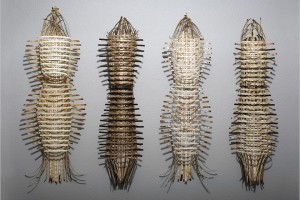Last weekend, I went to two very different fiber exhibits in Lowell, MA, an historic city that was once the home of many textile mills during the Industrial Revolution.
Lowell is a fascinating city, and it has done a good job of preserving its textile heritage. Both the Lowell National Historical Park and the American Textile History Museum have wonderful ongoing exhibits about the history of textiles in Lowell as well as about other industries that flourished at the heyday of manufacturing in the area. The city has done a good job of reusing many of its old textile factories, converting them into residences and mixed use spaces. It is also home to a number of galleries–including The Brush Art Gallery and Studios and the Whistler House Museum of Art, housed in the birthplace of James McNeill Whistler–that show rotating exhibits of visual art, including fiber art.
People from many different cultural backgrounds, including a large Cambodian population, now reside in Lowell. The city’s many wonderful restaurants and festivals reflect the origins of its population.
Every summer, the Whistler House Museum holds a juried art quilt exhibition focusing on a specific theme. This year’s theme was How Does Your Garden Grow? The exhibit is on view through September 20th. Below are the three winning pieces in the exhibit.
Down the street from the Whistler, the American Textile History Museum is showing a very different kind of fiber exhibition: Fiberart International 2013. Sponsored by the Pittsburgh Fiber Arts Guild and originally shown in Pittsburgh, this triennial exhibition features cutting edge fiber work by artists throughout the world. It is on view at the Textile History Museum through October 26th.
Below are some images from that exhibit.
Perhaps because I viewed both exhibits in close juxtaposition, I was struck by my different reactions to each of them. While I liked a few pieces in the Whistler show, overall I did not find it to my taste. It was a very representational show, and I already know that I personally prefer more abstract art. It also felt more like a traditional quilt show than a fiber show, which is not a surprise since the Whistler summer shows always focus on quilt art. While many of the pieces in the Whistler show were well done, both visually and technically, few felt innovative or were striking to me in any way.
The Fiberart International show had a completely different flavor. First, it contained many interpretations of the word “fiber,” and the participating artists used fiber in a surprising variety of ways. Second, many of the pieces in the exhibit pushed conventional boundaries. They used innovative materials, such as the plant material found in Anne Goebel’s piece. They were also innovative in their use of dimensionality, often bulging from the wall, hung around a corner, or stiffened to stand on their own. Most of the pieces in this exhibit were also quite large, asserting themselves through their sheer size. Another commonality was the use of a neutral palette. It was fascinating to see how much could be expressed using shades of white, gray, black and brown. Not every piece in the exhibit was successful, in my view. Some of the more conceptual pieces felt very cerebral and had little visual content.
My husband, however, had a completely opposite reaction to the two shows than I did. He loved the Whistler show and was intrigued by the colors of the work and the many ways in which participating artists interpreted the garden theme. He found the Fiberart International show boring, perhaps because of the subdued color palette used in many of the pieces. When we talked about a few of the pieces in the Fiberart show, and I explained some of the techniques that were used in the work, he became more intrigued, but this was on a different level from the pure visual.
For the past week, I have been thinking about these two exhibitions and pondering the question of how we arrive at our tastes and preference. Why do I prefer abstract art to representational art? Is it because I can read into the work whatever I wish or interpret it to mirror my own emotions? Why do I like art that uses a neutral palette, yet so often use intense colors in my own work? What gives a particular piece of art gravitas, distinguishing it from its many neighbors? What is the role of beauty in art, and why does beauty seem absent from so many contemporary exhibitions? I have no answers to these questions but am enjoying the process of thinking about them. I welcome readers’ comments on these questions.








2 comments
Comments feed for this article
September 1, 2014 at 7:53 pm
artquiltma
Diane, I prefer abstracts as well, and I think it’s for the same reason. I find things in the work and they make me think. I do love photographs of realistic work if it also engenders thoughts and feelings.
September 1, 2014 at 10:33 pm
Diane Franklin
I would love to understand why some people prefer realistic work to abstracts.
Like you, I enjoy realistic photographs. There is something about photography that is special and not like other representational art.